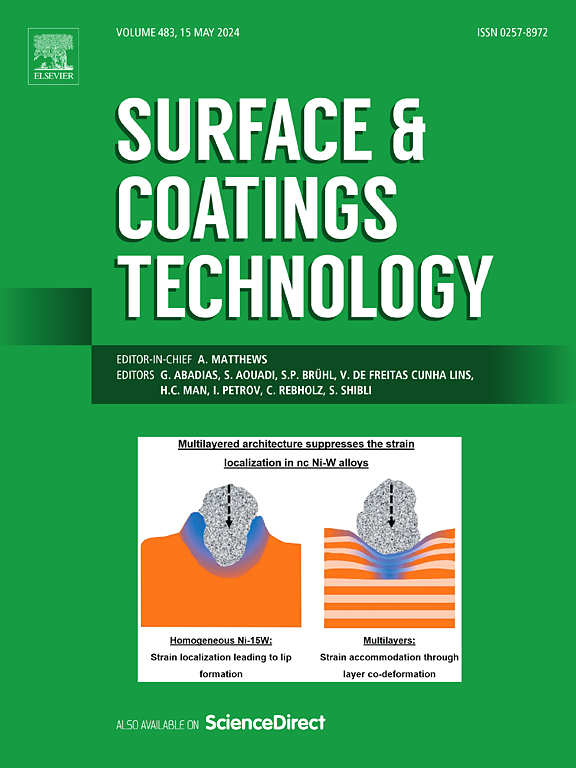退火和激光重熔等离子喷涂铁基非晶涂层的显微组织、断裂韧性和空化行为
IF 6.1
2区 材料科学
Q1 MATERIALS SCIENCE, COATINGS & FILMS
引用次数: 0
摘要
比较和讨论了不同后处理方法(退火处理和激光重熔处理)对等离子喷涂FeCrMoCB非晶涂层力学性能、空化行为和显微组织的影响。退火后涂层的断裂韧性为3.40 MPa·m1/2,比喷涂状态提高了41%。退火后涂层的显微硬度为1150.1 HV0.1,比喷涂状态的1058.8 HV0.1提高了91.3 HV0.1。激光重熔有效地消除了层状组织,使激光重熔涂层的断裂韧性达到8.31 MPa·m1/2,分别是退火涂层和喷涂涂层的2.44倍和3.44倍。激光重熔涂层的显微硬度为1172.7 HV0.1,比退火涂层高22.1 HV0.1。经空化试验10 h后,激光重熔涂层的总腐蚀质量损失显著降低至1.51 mg,分别为喷涂涂层和退火涂层的6.91%和11.72%。与退火相比,激光重熔在提高抗空化性能方面表现出更好的效果,这可能是由于激光重熔消除了缺陷,显微硬度得到了更大的提高,断裂韧性得到了显著提高。本文章由计算机程序翻译,如有差异,请以英文原文为准。

Microstructure, fracture toughness and cavitation behavior of plasma-sprayed Fe-based amorphous coating by annealing treatment and laser remelting
Effects of different post-treatment methods, including annealing treatment and laser remelting, on mechanical properties, cavitation behavior and microstructure of the plasma-sprayed FeCrMoCB amorphous coating are compared and discussed. With a fracture toughness value of 3.40 MPa·m1/2, the optimally annealed coating exhibits a 41 % increase than its as-sprayed state. The optimum annealed coating's microhardness is 1150.1 HV0.1, which increases by 91.3 HV0.1 than 1058.8 HV0.1 of its as-sprayed state. The layered structures are effectively elimilated in laser remelting process, thus improving the fracture toughness of the optimum laser-remelted coating to 8.31 MPa·m1/2, which is 2.44 times and 3.44 times those of the annealed coating and as-sprayed coating, respectively. The optimally laser-remelted coating achieves a microhardness of 1172.7 HV0.1, surpassing the optimally annealed coating by 22.1 HV0.1. The total mass loss from erosion for the optimally laser-remelted coating after 10 h of cavitation test significantly decreases to 1.51 mg, which is 6.91 % and 11.72 % those of the as-sprayed and optimally annealed coatings, respectively. The laser remelting exhibits a better effect in enhancing cavitation resistance than the annealing, which may be attributed to the defect elimination, greater enhancement in microhardness and the marked improvement in fracture toughness.
求助全文
通过发布文献求助,成功后即可免费获取论文全文。
去求助
来源期刊

Surface & Coatings Technology
工程技术-材料科学:膜
CiteScore
10.00
自引率
11.10%
发文量
921
审稿时长
19 days
期刊介绍:
Surface and Coatings Technology is an international archival journal publishing scientific papers on significant developments in surface and interface engineering to modify and improve the surface properties of materials for protection in demanding contact conditions or aggressive environments, or for enhanced functional performance. Contributions range from original scientific articles concerned with fundamental and applied aspects of research or direct applications of metallic, inorganic, organic and composite coatings, to invited reviews of current technology in specific areas. Papers submitted to this journal are expected to be in line with the following aspects in processes, and properties/performance:
A. Processes: Physical and chemical vapour deposition techniques, thermal and plasma spraying, surface modification by directed energy techniques such as ion, electron and laser beams, thermo-chemical treatment, wet chemical and electrochemical processes such as plating, sol-gel coating, anodization, plasma electrolytic oxidation, etc., but excluding painting.
B. Properties/performance: friction performance, wear resistance (e.g., abrasion, erosion, fretting, etc), corrosion and oxidation resistance, thermal protection, diffusion resistance, hydrophilicity/hydrophobicity, and properties relevant to smart materials behaviour and enhanced multifunctional performance for environmental, energy and medical applications, but excluding device aspects.
 求助内容:
求助内容: 应助结果提醒方式:
应助结果提醒方式:


